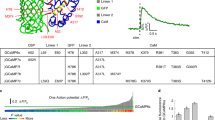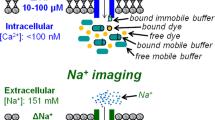Abstract
Recent technological advances have enabled the recording of neurons in intact circuits with a high spatial and temporal resolution, creating the need for modeling with the same precision. In particular, the development of ultra-fast two-photon microscopy combined with fluorescence-based genetically-encoded Ca2+-indicators allows capture of full-dendritic arbor and somatic responses associated with synaptic input and action potential output. The complexity of dendritic arbor structures and distributed patterns of activity over time results in the generation of incredibly rich 4D datasets that are challenging to analyze (Sakaki et al. in Frontiers in Neural Circuits 14:33, 2020). Interpreting neural activity from fluorescence-based Ca2+ biosensors is challenging due to non-linear interactions between several factors influencing intracellular calcium ion concentration and its binding to sensors, including the ionic dynamics driven by diffusion, electrical gradients and voltage-gated conductances. To investigate those dynamics, we designed a model based on a Cable-like equation coupled to the Nernst-Planck equations for ionic fluxes in electrolytes. We employ this model to simulate signal propagation and ionic electrodiffusion across a dendritic arbor. Using these simulation results, we then designed an algorithm to detect synapses from Ca2+ imaging datasets. We finally apply this algorithm to experimental Ca2+-indicator datasets from neurons expressing jGCaMP7s (Dana et al. in Nature Methods 16:649–657, 2019), using full-dendritic arbor sampling in vivo in the Xenopus laevis optic tectum using fast random-access two-photon microscopy. Our model reproduces the dynamics of visual stimulus-evoked jGCaMP7s-mediated calcium signals observed experimentally, and the resulting algorithm allows prediction of the location of synapses across the dendritic arbor. Our study provides a way to predict synaptic activity and location on dendritic arbors, from fluorescence data in the full dendritic arbor of a neuron recorded in the intact and awake developing vertebrate brain.





Similar content being viewed by others
Abbreviations
- NMDA:
-
N-methyl D-aspartate
- VGCC:
-
Voltage-gated calcium channels
References
Aggarwal, A., Liu, R., Chen, Y., Ralowicz, A. J., Bergerson, S. J., Tomaska, F., Hanson, T. L., Hasseman, J. P., Reep, D., Tsegaye, G., Yao, P., Ji, X., Kloos, M., Walpita, D., Patel, R., Mohr, M. A., Tilberg, P. W., Mohar, B., Looger, L. L., ... & Podgorski, K. (2022). Glutamate indicators with improved activation kinetics and localization for imaging synaptic transmission. bioRxiv. https://doi.org/10.1101/2022.02.13.480251
Alberts, B., Johnson, A., Lewis, J., Raff, M., Roberts, K., & Walter, P. (2002). Molecular Biology of the Cell. Garland Science.
Basak, R., & Narayanan, R. (2018). Active dendrites regulate the spatiotemporal spread of signaling microdomains. PLoS Comp Bio, 14, e1006485.
Bono, J., & Clopath, C. (2017). Modeling somatic and dendritic spike mediated plasticity at the single neuron and network level. Nature Communications, 8(1), 706.
Bower, J. M., & Beeman, D. (1998). The Book of GENESIS: Exploring realistic neural models with the GEneral NEural SImulation System (2nd ed.). Springer-Verlag.
Brette, R., & Gerstner, W. (2005). Adaptive exponential integrate-and-fire model as an effective description of neuronal activity. Journal of Neurophysiology, 94(5), 3637–3642.
Carnevale, T., & Hines, M. (2006). The NEURON Book. Cambridge University Press.
Cartailler, J., Schuss, Z., & Holcman, D. (2017). Electrostatics of non-neutral biological microdomains. Science and Reports, 7(1), 11269.
Dana, H., Sun, Y., Mohar, B., Hulse, B. K., Kerlin, A. M., Hasseman, J. P., Tsegaye, G., Tsang, A., Wong, A., Patel, R., Macklin, J. J., Chen, Y., Konnerth, A., Jayaraman, V., Looger, L. L., Schreiter, E. R., Svoboda, K., & Kim, D. S. (2019). High-performance calcium sensors for imaging activity in neuronal populations and microcompartments. Nature Methods, 16, 649–657.
Demas, J. A., Payne, H., & Cline, H. T. (2012). Vision drives correlated activity without patterned spontaneous activity in developing Xenopus retina. Developmental Neurobiology, 72, 537–546.
Dou, Y., Lin, Y., Wang, T. Y., Wang, X. Y., Jia, Y., & l., & Zhao, C. P. (2020). The CAG promoter maintains high-level transgene expression in HEK293 cells. FEBS Open Bio, 11(1), 95–104.
Engert, F., Tao, H. W., Zhang, L. I., & Poo, M. M. (2002). Moving visual stimuli rapidly induce direction sensitivity of developing tectal neurons. Nature, 419(6906), 470–475.
Galtier, N., & Guerrier, C. (2022). Sinaps: a Python library to simulate voltage dynamics and ionic electrodiffusion in neurons. Journal of Open Source Software, 7(73), 4012.
Gonzalez, K. C., Losonczy, A., & Negrean, A. (2022). Dendritic excitability and synaptic plasticity in vitro and in vivo. Neuroscience, 489, 165–175.
Gross, G. G., Junge, J. A., Mora, R. J., Kwon, H. B., Olson, C. A., Takahashi, T. T., Liman, E. R., Ellis-Davies, G. C., McGee, A. W., Sabatini, B. L., Roberts, R. W., & Arnold, D. B. (2013). Recombinant probes for visualizing endogenous synaptic proteins in living neurons. Neuron, 78(6), 971–985.
Guerrier, C., & Holcman, D. (2017). Multiscale models and stochastic simulation methods for computing rare but key binding events in cell biology. Journal of Computational Physics, 340, 617–638.
Haas, K., Sin, W. C., Javaherian, A., Li, Z., & Cline, H. T. (2001). Single-cell electroporation for gene transfer in vivo. Neuron, 29(3), 583–591.
Harkin, E. F., Béïque, J. C., & Naud, R. (2022). A user’s guide to generalized integrate-and-fire models. Advances in Experimental Medicine and Biology, 1359, 69–86.
Hodgkin, A. L., & Huxley, A. F. (1952). A quantitative description of membrane current and its application to conduction and excitation in nerve. Journal of Physiology, 117(4), 500–544.
Holcman, D., & Yuste, R. (2015). The new nanophysiology: Regulation of ionic flow in neuronal subcompartments. Nature Reviews Neuroscience, 16, 685–692.
Honda, M., Urakubo, H., Tanaka, K., & Kuroda, S. (2011). Analysis of development of direction selectivity in retinotectum by a neural circuit model with spike timing-dependent plasticity. Journal of Neuroscience, 31(4), 1516–1527.
Izhikevich, E. M. (2007). Dynamical systems in neuroscience - the geometry of excitability and bursting. The MIT Press.
Kazemipour, A., Novak, O., Flickinger, D., Marvin, J. S., Abdelfattah, M., King, J., Borden, P. M., Kim, J. J., Abdullatif, S., Deal, P. E., Miller, E. W., Schreiter, E. R., Druckmann, S., Svoboda, K., Looger, L. L., & Podgorski, K. (2019). Kilohertz frame-rate two-photon tomography. Nature Methods., 16(8), 778–786.
Keener, J. P., Hoppensteadt, F. C., & Rinzel, J. (1981). Integrate-and-fire models of nerve membrane response to oscillatory input. SIAM Journal on Applied Mathematics, 41(3), 503–517.
Kim, J. H., Lee, S. R., Li, L. H., Park, H. J., Lee, K. Y., Kim, M. K., Shin, B. A., & Choi, S. Y. (2011). High cleavage efficiency of a 2A peptide derived from porcine teschovirus-1 in human cell lines, zebrafish and mice. PLoS One, 6, e18556
Kirby, B. J. (2010). Micro- and nanoscale fluid mechanics. Cambridge University Press.
Koch, C. (1999). Biophysics of computation, information processing in single neurons. Oxford University Press.
Laviv, T., Kim, B. B., Chu, J., Lam, A. J., Lin, M. Z., & Yasuda, R. (2016). Simultaneous dual-color fluorescence lifetime imaging with novel red-shifted fluorescent proteins. Nature Methods, 13(12), 989–992.
Lavzin, M., Rapoport, S., Polsky, A., Garion, L., & Schiller, J. (2012). Nonlinear dendritic processing determines angular tuning of barrel cortex neurons in vivo. Nature, 490(7420), 397–401.
Li, J., Erisir, A., & Cline, H. (2011). In vivo time-lapse imaging and serial section electron microscopy reveal developmental synaptic rearrangements. Neuron, 69(2), 273–286.
London, M., & Häusser, M. (2005). Dendritic computation. Annual Review of Neuroscience, 28, 503–532.
Lopreore, C. L., Bartol, T. M., Coggan, J. S., Keller, D. X., Sosinsky, G. E., Ellisman, M. H., & Sejnowski, T. J. (2008). Computational modeling of three-dimensional electrodiffusion in biological systems: Application to the node of ranvier. Biophysical Journal, 95(6), 2624–2635.
Lu, B., Holst, M. J., McCammon, J. A., & Zhou, Y. C. (2010). Poisson-Nernst Planck equations for simulating biomolecular diffusion-reaction processes. I. finite element solutions. Journal of Computational Physics, 229, 6979–6994.
Mory, Y., Fishman, G. I., & Peskin, C. S. (2008). Ephaptic conduction in a cardiac strand model with 3D electrodiffusion. Proceedings of the National Academy of Sciences of the United States of America, 105, 6463–6468.
Nernst, W. (1888). Zur kinetik der in lösung befindlichen körper. Zeitschr f Phys Chem, 2, 613–637.
Øyehaug, L., Østby, I., Lloyd, C. M., Omholt, S. W., & Gaute, T. E. (2012). Dependence of spontaneous neuronal firing and depolarisation block on astroglial membrane transport mechanisms. Journal of Computational Neuroscience, 32(1), 147–165.
Pods, J., Schonke, J., & Bastian, P. (2013). Electrodiffusion models of neurons and extracellular space using the Poisson-Nernst-Planck equations: Numerical simulation of the intra- and extracellular potential for an axon model. Biophysical Journal, 105(1), 242–254.
Qian, N., & Sejnowski, T. J. (1989). An electro-diffusion model for computing membrane potentials and ionic concentrations in branching dendrites, spines and axons. Biological Cybernetics, 62, 1–15.
Redmond, L., & Ghosh, A. (2005). Regulation of dendritic development by calcium signaling. Cell Calcium, 37(5), 411–416.
Sætra, M. J., Einevoll, G. T., & Halnes, G. (2020). An electrodiffusive, ion conserving pinsky-rinzel model with homeostatic mechanisms. PLOS Computational Biology, 16(4), 1–36.
Sakaki, K. D. R., Podgorski, K., Dellazizzo Toth, T. A., Coleman, P., & Haas, K. (2020). Comprehensive imaging of sensory-evoked activity of entire neurons within the awake developing brain using ultrafast aod-based random-access two-photon microscopy. Frontiers in Neural Circuits, 14, 33.
Savtchenko, L. P., Ming Poo, M., & Rusakov, D. A. (2017). Electrodiffusion phenomena in neuroscience: a neglected companion. Nature Reviews Neuroscience, 18, 598–612.
Segal, M., & Korkotian, E. (2014). Endoplasmic reticulum calcium stores in dendritic spines. Frontiers in Neuroanatomy, 8, 64.
Solbra, A., Bergersen, A. W., van den Brink, J., Malthe-Sørenssen, A., Einevoll, G. T., & Halnes, G. (2018). A kirchhoff-nernst-planck framework for modeling large scale extracellular electrodiffusion surrounding morphologically detailed neurons. PLOS Computational Biology, 14(10), 1–26.
Stinchcombe, A. R., Mory, Y., & Peskin, C. S. (2016). Well-posed treatment of space-charge layers in the electroneutral limit of electrodiffusion. Communications on Pure and Applied Mathematics, 69(12), 2221–2249.
Waters, J., Schaefer, A., & Sakmann, B. (2005). Backpropagating action potentials in neurons: Measurement, mechanisms and potential functions. Progress in Biophysics and Molecular Biology, 87(1), 145–170.
Wu, G. Y., Malinow, R., & Cline, H. T. (1996). Maturation of a central glutamatergic synapse. Science, 274(5289), 972–976.
Xylouris, K., Queisser, G., & Wittum, G. (2010). A three-dimensional mathematical model of active signal processing in axons. Computer Visualization Science, 13, 409–418.
Funding
Financial support from CIHR grant #FDN-148468, AccelNet International Network for Bio-Inspired Computing and the Fyssen foundation is gratefully acknowledged.
Author information
Authors and Affiliations
Contributions
KH designed the project. CG and NG built the model and did the simulations. TDT performed experiments. CG, TDT and KH wrote the main manuscript text. TDT and CG prepared Fig. 1. NG prepared Figs. 2, 3, 4, and 5. All authors reviewed the manuscript.
Corresponding author
Ethics declarations
Ethics Approval
The animal study was reviewed and approved by the UBC Animal Care Committee and was in accordance with the Canadian Council on Animal Care (CCAC) guidelines. Animal Care Number: A190297.
Consent to Participate
Not applicable.
Competing Interests
The authors declare no conflict of interest.
Additional information
Publisher's Note
Springer Nature remains neutral with regard to jurisdictional claims in published maps and institutional affiliations.
Rights and permissions
Springer Nature or its licensor (e.g. a society or other partner) holds exclusive rights to this article under a publishing agreement with the author(s) or other rightsholder(s); author self-archiving of the accepted manuscript version of this article is solely governed by the terms of such publishing agreement and applicable law.
About this article
Cite this article
Guerrier, C., Dellazizzo Toth, T., Galtier, N. et al. An Algorithm Based on a Cable-Nernst Planck Model Predicting Synaptic Activity throughout the Dendritic Arbor with Micron Specificity. Neuroinform 21, 207–220 (2023). https://doi.org/10.1007/s12021-022-09609-z
Accepted:
Published:
Issue Date:
DOI: https://doi.org/10.1007/s12021-022-09609-z




